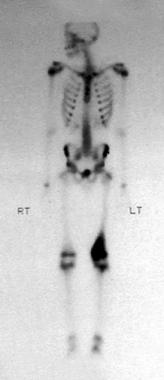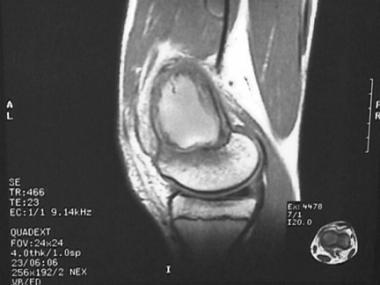

Osteosarcoma of bone is a high-grade tumor with a long-term survival rate of 60-85%. Several variants of osteosarcoma exist.[1, 2] High-grade variants include telangiectatic osteosarcoma, small-cell osteosarcoma, high-grade surface osteosarcoma, and secondary osteosarcoma. Other variants, such as low-grade central osteosarcoma (see images below), parosteal osteosarcoma, and periosteal osteosarcoma, are less aggressive entities with a lower rate of metastasis and a long-term survival rate approaching 90%. Low-grade central osteosarcoma is a rare variant of osteosarcoma that is often mistaken for fibrous dysplasia.[3] (See also Osteosarcoma Variant Imaging and Parosteal Osteosarcoma.)
 Bone scan of a low-grade central osteosarcoma of the distal femur.
Bone scan of a low-grade central osteosarcoma of the distal femur.
 Magnetic resonance image (MRI) of low-grade central osteosarcoma of the distal femur.
Magnetic resonance image (MRI) of low-grade central osteosarcoma of the distal femur.
Initial diagnosis of osteosarcoma is often difficult.[4, 5] Frequently, it is diagnosed only after a recurrence of disease in an area of bone where a diagnosis of fibrous dysplasia had previously been made.[6] Osteosarcoma has also been mistaken for other benign and malignant bone conditions, including nonossifying fibroma, well-differentiated fibrosarcoma, aneurysmal bone cyst, osteoblastoma, and desmoplastic fibroma.[7, 8] Its rarity likely contributes to these inaccurate diagnoses.
To the author's knowledge, the largest series in the literature to date is that of Kurt and colleagues, which was published in 1990 and included 80 cases.[9] Low-grade central osteosarcoma has a better prognosis than that of high-grade osteosarcoma. (See also Imaging in Fibrous Cortical Defect and Nonossifying Fibroma, Fibrosarcoma, Aneurysmal Bone Cyst [Orthopedic Surgery], Aneurysmal Bone Cyst Imaging, Osteoblastoma [Orthopedic Surgery], and Osteoblastoma Imaging.)
NextLow-grade central osteosarcoma is a rare variant of osteosarcoma that originates within the medullary cavity of bone. At histologic examination, it appears as a Broders grade 1 or grade 2 lesion. The Broders grading system was designed to determine the grade of malignancy of a given tumor on the basis of histologic features.[10] These characteristics include the following:
The above-mentioned study by Kurt and coauthors revealed low-grade central osteosarcoma accounts for 1.2-1.9% of all cases of osteosarcoma.[9]
Internationally, low-grade central osteosarcoma accounts for 0.7% of all cases of osteosarcoma, as reported by the Instituto de Rizzoli at the University of Bologna, Italy.
The exact etiology of low-grade central osteosarcoma is unknown. Osteosarcomas have been experimentally induced in animals by a variety of means, including irradiation,[11] inoculation with Moloney sarcoma virus,[12] injection of bone-seeking radionucleotides,[13] and inhalation of aerosolized plutonium 238 dioxide.[14] Many of these induced tumors are well-differentiated osteosarcomas, including low-grade central osteosarcomas.
Low-grade central osteosarcomas typically develop de novo in the long bones of patients aged 20-30 years. Patients typically seek treatment when symptoms, which usually involve pain only at the site of the tumor, persist. The tumor grows locally within the bone of origin. Approximately 25-55% of these tumors invade the surrounding, adjacent soft tissue. If the tumor is not adequately resected early in its course, pulmonary metastasis may develop as a late complication.
The mean patient age at presentation is 28.3 years. Patients with low-grade central osteosarcoma are approximately 1 decade older than patients with traditional osteosarcoma, although cases have been reported in patients aged 9-83 years.
The male-to-female ratio is 1:1; this is unlike traditional osteosarcoma, which has a male-to-female ratio of 1.4:1.
Pain is the most common symptom of low-grade central osteosarcoma; this is sometimes associated with local swelling. Typically, the duration of symptoms is long, with a mean of 1.8 years. About 5% of cases are found incidentally on radiographs obtained during an examination for reasons other than the evaluation of low-grade central osteosarcoma. Pathologic fractures are rare.
Because of its potential for metastasis and local, infiltrative destruction, the presence of a low-grade central osteosarcoma is an indication for treatment.
Low-grade central osteosarcoma may occur in the following locations:
The only contraindication to the treatment of osteosarcoma is the presence of widespread metastases. Palliative treatment may then be indicated.
Workup
Copyright © www.orthopaedics.win Bone Health All Rights Reserved